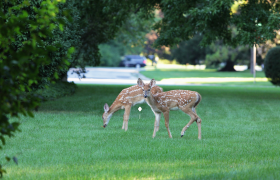Deer Prevention

The New Jersey deer population is on the rise. White tail deer are known as “edge species” because their habitat is openings in forests created by agricultural practices. New Jersey provides deer with plenty of food but does not have enough predators to keep the population in check. When hungry deer come up to your house and start chomping away at your garden, here are some tips to deter them: Choose deer resistant plants. The Cooperative Extension of Bergen County (201- 336- 6780) can assist you in choosing plants that deer tend to avoid in our area. While no plant is completely ‘deer-proof’, it is very helpful to exclude their favorites from your landscape design.
Fencing is a great prevention method but can also be a costly one. There are several different types of fencing, but height is key. Deer can easily jump over fencing less than eight feet high. Electric fencing is more of a psychological barrier than a physical barrier. When a deer gets close to the fence, it gives off a timed pulse in a short duration to their nose or tongue. Wrapping trees in netting, chicken wire or wire mesh helps stop male deer from rubbing their antlers on your trees (to remove the velvet) while damaging your young trees in the process. If you are thinking about installing a fence, please contact your local Planning and Zoning Department for permits and regulations.
Another preventative measure is chemical or organic deer repellents. Commercial and home-made repellents create unpleasant tastes, odors, stomach troubles, or pain when the active ingredients meet eyes, nose, or mucous membranes. Ask someone at your local hardware store, garden center or farming supply outlet which repellent works best for your area. If you are thinking about using repellent, it is best applied before the deer’s eating pattern is established. (March is ideal – so mark your calendar for next year!) During the growing season, apply the repellent on new plant growth, after heavy rains, and consistently every two to three weeks. Alternate the repellent you are using as deer grow accustomed to scents and tastes. During the peak of growth season, use an odor repellent over a taste one. (But go ahead and reapply the taste repellent on new growth only to keep the whole plant tasting bad.) Hang soaps with fatty acids and strong scents around the plants you want to protect. Changing things around keeps the deer on their toes and cautious.
Scare type devices can be used as another preventative measure. These are generally mechanical items that spin or move in the breeze, or noise emitting devices (ultrasonic and audible) that deer find unpleasant. This method works best when paired with another repellent method and when you periodically alternate the devices and locations, they are set up in. If deer are hungry enough to venture in your garden, they will quickly learn that your ‘scare tactics’ are empty threats and your tasty landscape is theirs for the taking.
Lastly do not feed the wildlife. By feeding wildlife it can attract unwanted company of other wildlife like rodents. Letting your dog roam free in a fenced in yard can help deter the deer as well. Armed with these tips and with some patience and fortitude, you can outwit the deer and enjoy your landscape and the fruits (and vegetables!) of your labor
| Attachment | Size |
|---|---|
| 65.83 KB |

